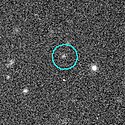Stefano (księżyc)
| ||
 Zdjęcie, na którym odkryto księżyc | ||
| Planeta | Uran | |
| Odkrywca | Brett Gladman, Matthew Holman, John Kavelaars, Jean-Marc Petit, Hans Scholl[1] | |
| Data odkrycia | 18 lipca 1999[1] | |
| Tymczasowe oznaczenie | S/1999 U2 | |
| Charakterystyka orbity | ||
| Półoś wielka | 8 007 400 km[2] | |
| Mimośród | 0,2248[2] | |
| Okres obiegu | 677,47 d[2] | |
| Nachylenie do ekliptyki | 143,819°[2] | |
| Długość węzła wstępującego | 191,411°[2] | |
| Argument perycentrum | 14,956°[2] | |
| Anomalia średnia | 270,163°[2] | |
| Własności fizyczne | ||
| Średnica równikowa | 32 km[3] | |
| Średnia gęstość | 1,5 g/cm³[3] | |
| Albedo | 0,04[3] | |
| Jasność obserwowana (z Ziemi) | 24,1m[3] | |
Stefano (Uran XX) – niewielki, zewnętrzny księżyc Urana, poruszający się ruchem wstecznym. Został odkryty przez Bretta J. Gladmana i jego zespół w 1999 roku za pomocą Teleskopu Kanadyjsko-Francusko-Hawajskiego na Mauna Kea[1]. Nazwa pochodzi od imienia kamerdynera-pijaka z Burzy Williama Szekspira[1].
Zobacz też
Przypisy
- ↑ a b c d Stephano (ang.). W: Solar System Exploration [on-line]. NASA. [dostęp 2018-12-25].
- ↑ a b c d e f g Planetary Satellite Mean Orbital Parameters (ang.). Jet Propulsion Laboratory, 2013-08-23. [dostęp 2016-02-12].
- ↑ a b c d Planetary Satellite Physical Parameters (ang.). Jet Propulsion Laboratory, 2015-02-19. [dostęp 2016-02-12].
Linki zewnętrzne
- Stephano (ang.). W: Solar System Exploration [on-line]. NASA. [dostęp 2018-12-25].
Media użyte na tej stronie
This is a revised version of Solar_System_XXIX.png.
Autor: Brett J. Gladman/Observatoire de la Cote d'Azur, Licencja: CC BY-SA 2.0
Photograph of Stephano, a moon of Uranus.
This image of Uranus was compiled from images returned Jan. 17, 1986, by the narrow-angle camera of Voyager 2. The spacecraft was 9.1 million kilometers (5.7 million miles) from the planet, several days from closest approach. This picture has been processed to show Uranus as human eyes would see it from the vantage point of the spacecraft. The picture is a composite of images taken through blue, green and orange filters. The darker shadings at the upper right of the disk correspond to the day-night boundary on the planet. Beyond this boundary lies the hidden northern hemisphere of Uranus, which currently remains in total darkness as the planet rotates. The blue-green color results from the absorption of red light by methane gas in Uranus' deep, cold and remarkably clear atmosphere.



